Capital Market Securities: Risk, Returns, and Investment Strategies
VerifiedAdded on 2023/06/10
|12
|3481
|455
Report
AI Summary
This report provides a comprehensive analysis of capital market securities, nonmarketable financial assets, and derivative securities. It begins by identifying the risks and returns associated with each investment alternative, including shares, bonds, and debt instruments. The report then delves into risk management strategies, such as securitization, maintaining NOI growth, and hedging techniques for derivatives, to mitigate potential losses. It also examines how to manage risks related to inflation and interest rates. The report concludes with investment recommendations, including the selection of specific financial assets and the rationale behind these choices, supported by necessary assumptions. The report uses examples from the Malaysian market to illustrate key concepts and provides insights into portfolio diversification and the importance of balancing risk and return. Finally, it offers a practical guide for investors seeking to navigate the complexities of capital markets and build a robust investment strategy.
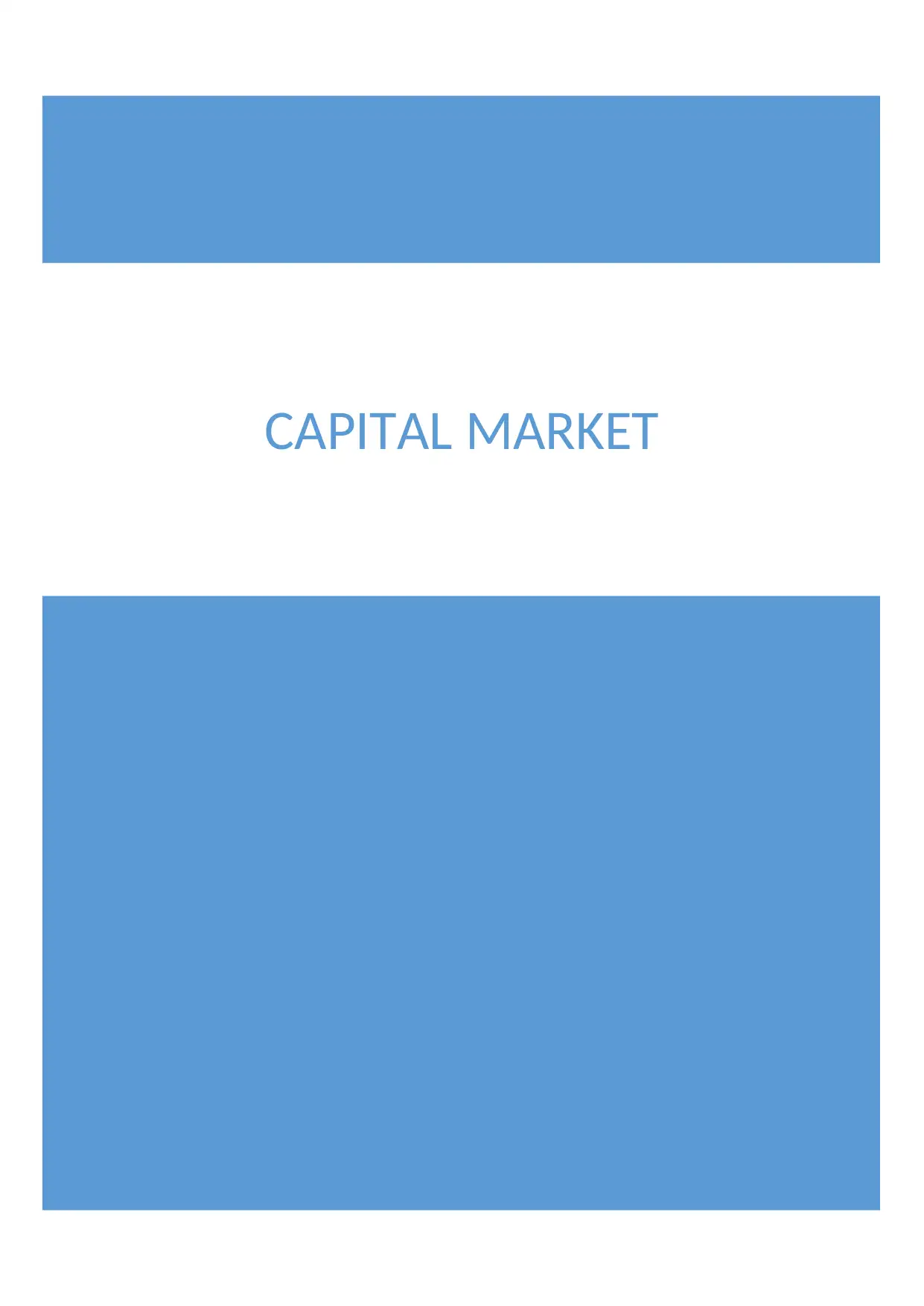
CAPITAL MARKET
Paraphrase This Document
Need a fresh take? Get an instant paraphrase of this document with our AI Paraphraser
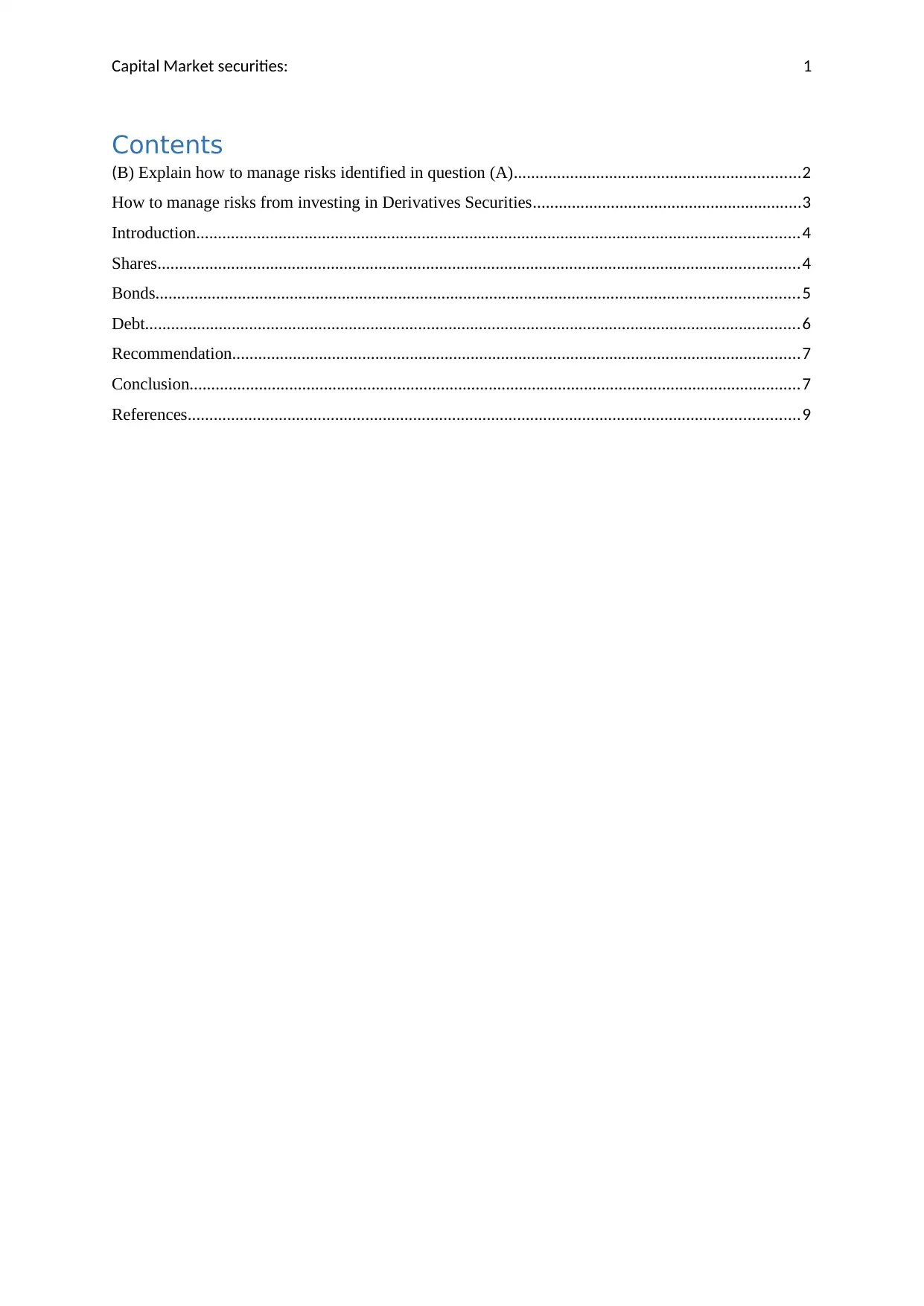
Capital Market securities: 1
Contents
(B) Explain how to manage risks identified in question (A)..................................................................2
How to manage risks from investing in Derivatives Securities..............................................................3
Introduction...........................................................................................................................................4
Shares....................................................................................................................................................4
Bonds....................................................................................................................................................5
Debt.......................................................................................................................................................6
Recommendation...................................................................................................................................7
Conclusion.............................................................................................................................................7
References.............................................................................................................................................9
Contents
(B) Explain how to manage risks identified in question (A)..................................................................2
How to manage risks from investing in Derivatives Securities..............................................................3
Introduction...........................................................................................................................................4
Shares....................................................................................................................................................4
Bonds....................................................................................................................................................5
Debt.......................................................................................................................................................6
Recommendation...................................................................................................................................7
Conclusion.............................................................................................................................................7
References.............................................................................................................................................9
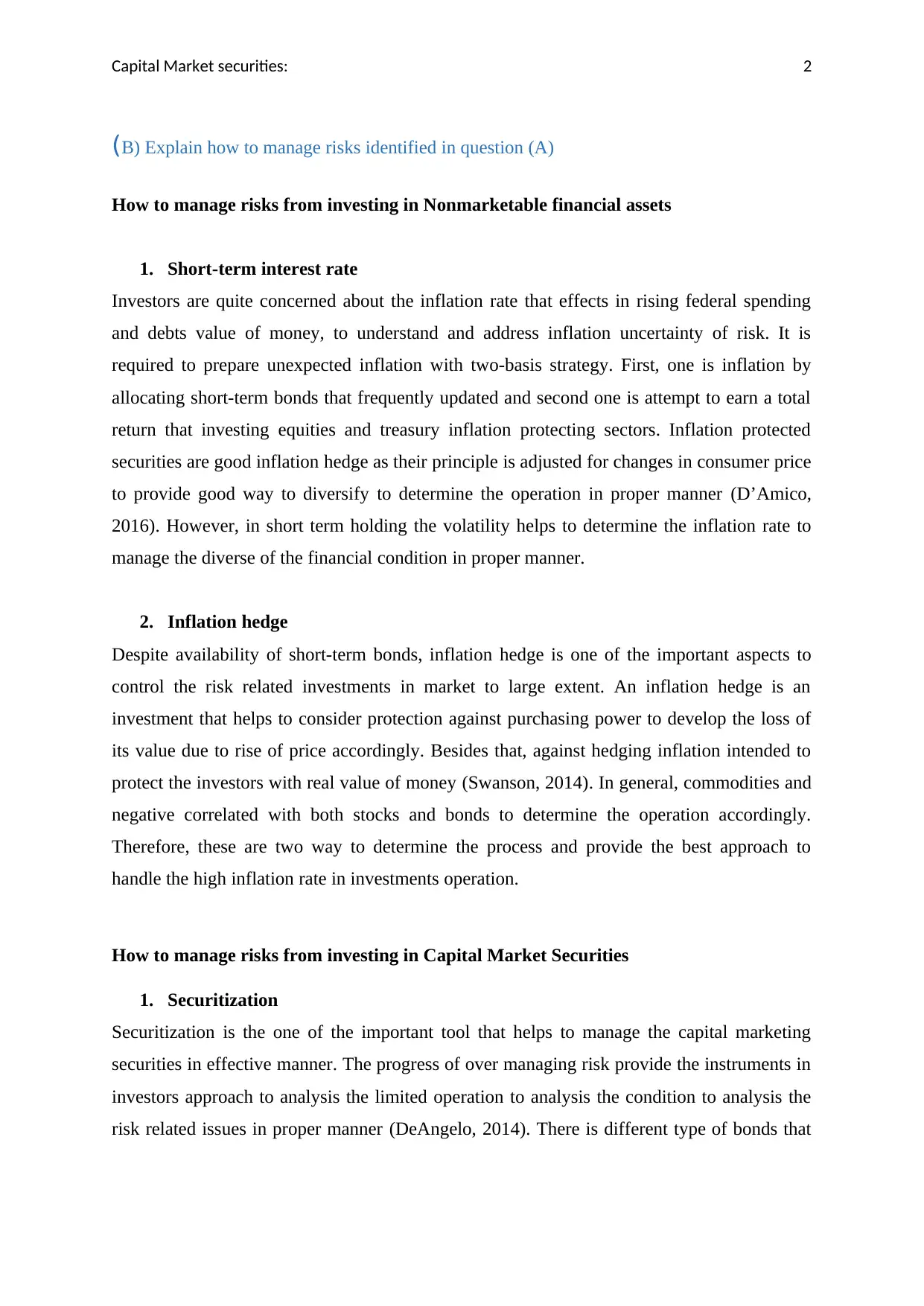
Capital Market securities: 2
(B) Explain how to manage risks identified in question (A)
How to manage risks from investing in Nonmarketable financial assets
1. Short-term interest rate
Investors are quite concerned about the inflation rate that effects in rising federal spending
and debts value of money, to understand and address inflation uncertainty of risk. It is
required to prepare unexpected inflation with two-basis strategy. First, one is inflation by
allocating short-term bonds that frequently updated and second one is attempt to earn a total
return that investing equities and treasury inflation protecting sectors. Inflation protected
securities are good inflation hedge as their principle is adjusted for changes in consumer price
to provide good way to diversify to determine the operation in proper manner (D’Amico,
2016). However, in short term holding the volatility helps to determine the inflation rate to
manage the diverse of the financial condition in proper manner.
2. Inflation hedge
Despite availability of short-term bonds, inflation hedge is one of the important aspects to
control the risk related investments in market to large extent. An inflation hedge is an
investment that helps to consider protection against purchasing power to develop the loss of
its value due to rise of price accordingly. Besides that, against hedging inflation intended to
protect the investors with real value of money (Swanson, 2014). In general, commodities and
negative correlated with both stocks and bonds to determine the operation accordingly.
Therefore, these are two way to determine the process and provide the best approach to
handle the high inflation rate in investments operation.
How to manage risks from investing in Capital Market Securities
1. Securitization
Securitization is the one of the important tool that helps to manage the capital marketing
securities in effective manner. The progress of over managing risk provide the instruments in
investors approach to analysis the limited operation to analysis the condition to analysis the
risk related issues in proper manner (DeAngelo, 2014). There is different type of bonds that
(B) Explain how to manage risks identified in question (A)
How to manage risks from investing in Nonmarketable financial assets
1. Short-term interest rate
Investors are quite concerned about the inflation rate that effects in rising federal spending
and debts value of money, to understand and address inflation uncertainty of risk. It is
required to prepare unexpected inflation with two-basis strategy. First, one is inflation by
allocating short-term bonds that frequently updated and second one is attempt to earn a total
return that investing equities and treasury inflation protecting sectors. Inflation protected
securities are good inflation hedge as their principle is adjusted for changes in consumer price
to provide good way to diversify to determine the operation in proper manner (D’Amico,
2016). However, in short term holding the volatility helps to determine the inflation rate to
manage the diverse of the financial condition in proper manner.
2. Inflation hedge
Despite availability of short-term bonds, inflation hedge is one of the important aspects to
control the risk related investments in market to large extent. An inflation hedge is an
investment that helps to consider protection against purchasing power to develop the loss of
its value due to rise of price accordingly. Besides that, against hedging inflation intended to
protect the investors with real value of money (Swanson, 2014). In general, commodities and
negative correlated with both stocks and bonds to determine the operation accordingly.
Therefore, these are two way to determine the process and provide the best approach to
handle the high inflation rate in investments operation.
How to manage risks from investing in Capital Market Securities
1. Securitization
Securitization is the one of the important tool that helps to manage the capital marketing
securities in effective manner. The progress of over managing risk provide the instruments in
investors approach to analysis the limited operation to analysis the condition to analysis the
risk related issues in proper manner (DeAngelo, 2014). There is different type of bonds that
⊘ This is a preview!⊘
Do you want full access?
Subscribe today to unlock all pages.

Trusted by 1+ million students worldwide
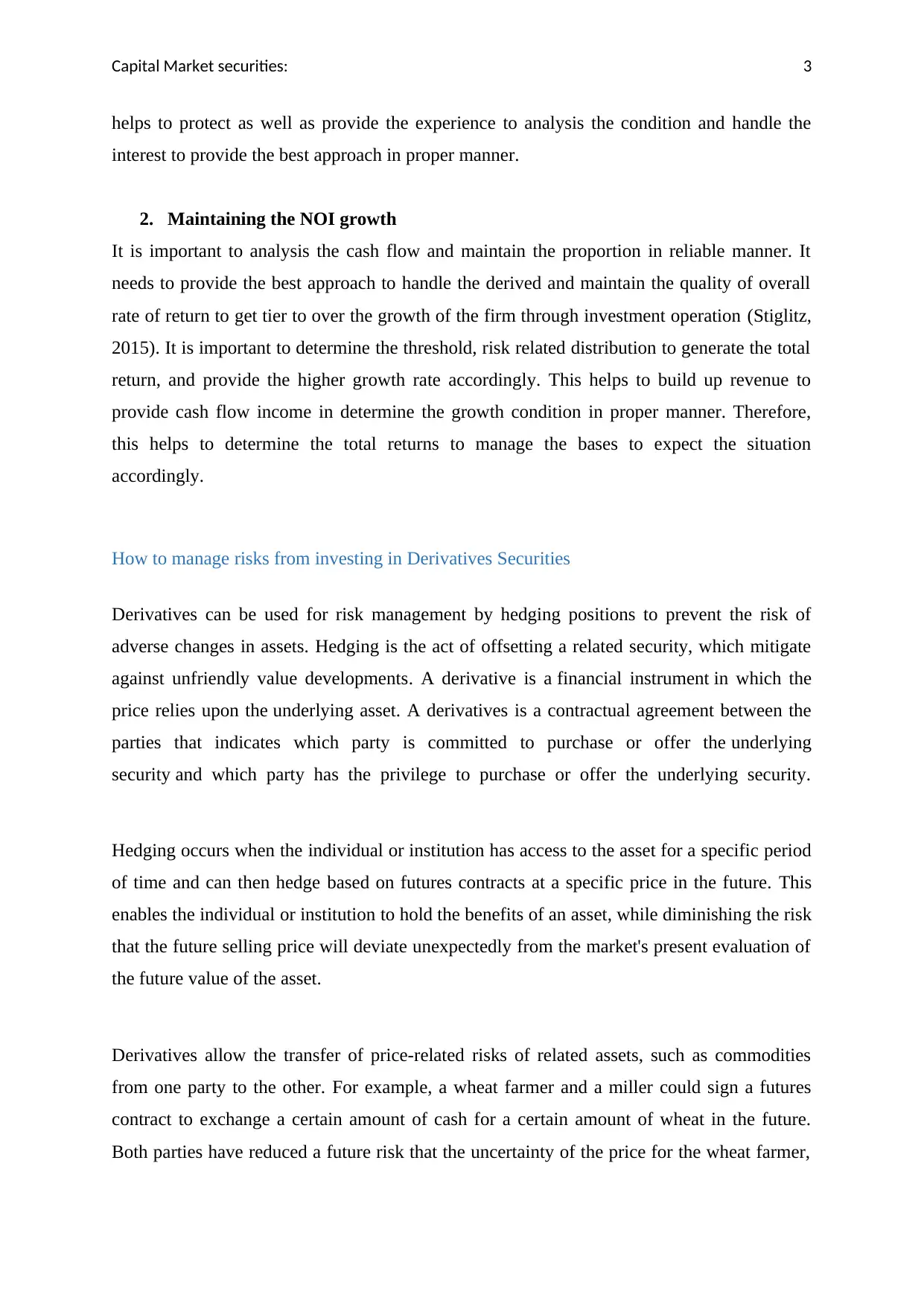
Capital Market securities: 3
helps to protect as well as provide the experience to analysis the condition and handle the
interest to provide the best approach in proper manner.
2. Maintaining the NOI growth
It is important to analysis the cash flow and maintain the proportion in reliable manner. It
needs to provide the best approach to handle the derived and maintain the quality of overall
rate of return to get tier to over the growth of the firm through investment operation (Stiglitz,
2015). It is important to determine the threshold, risk related distribution to generate the total
return, and provide the higher growth rate accordingly. This helps to build up revenue to
provide cash flow income in determine the growth condition in proper manner. Therefore,
this helps to determine the total returns to manage the bases to expect the situation
accordingly.
How to manage risks from investing in Derivatives Securities
Derivatives can be used for risk management by hedging positions to prevent the risk of
adverse changes in assets. Hedging is the act of offsetting a related security, which mitigate
against unfriendly value developments. A derivative is a financial instrument in which the
price relies upon the underlying asset. A derivatives is a contractual agreement between the
parties that indicates which party is committed to purchase or offer the underlying
security and which party has the privilege to purchase or offer the underlying security.
Hedging occurs when the individual or institution has access to the asset for a specific period
of time and can then hedge based on futures contracts at a specific price in the future. This
enables the individual or institution to hold the benefits of an asset, while diminishing the risk
that the future selling price will deviate unexpectedly from the market's present evaluation of
the future value of the asset.
Derivatives allow the transfer of price-related risks of related assets, such as commodities
from one party to the other. For example, a wheat farmer and a miller could sign a futures
contract to exchange a certain amount of cash for a certain amount of wheat in the future.
Both parties have reduced a future risk that the uncertainty of the price for the wheat farmer,
helps to protect as well as provide the experience to analysis the condition and handle the
interest to provide the best approach in proper manner.
2. Maintaining the NOI growth
It is important to analysis the cash flow and maintain the proportion in reliable manner. It
needs to provide the best approach to handle the derived and maintain the quality of overall
rate of return to get tier to over the growth of the firm through investment operation (Stiglitz,
2015). It is important to determine the threshold, risk related distribution to generate the total
return, and provide the higher growth rate accordingly. This helps to build up revenue to
provide cash flow income in determine the growth condition in proper manner. Therefore,
this helps to determine the total returns to manage the bases to expect the situation
accordingly.
How to manage risks from investing in Derivatives Securities
Derivatives can be used for risk management by hedging positions to prevent the risk of
adverse changes in assets. Hedging is the act of offsetting a related security, which mitigate
against unfriendly value developments. A derivative is a financial instrument in which the
price relies upon the underlying asset. A derivatives is a contractual agreement between the
parties that indicates which party is committed to purchase or offer the underlying
security and which party has the privilege to purchase or offer the underlying security.
Hedging occurs when the individual or institution has access to the asset for a specific period
of time and can then hedge based on futures contracts at a specific price in the future. This
enables the individual or institution to hold the benefits of an asset, while diminishing the risk
that the future selling price will deviate unexpectedly from the market's present evaluation of
the future value of the asset.
Derivatives allow the transfer of price-related risks of related assets, such as commodities
from one party to the other. For example, a wheat farmer and a miller could sign a futures
contract to exchange a certain amount of cash for a certain amount of wheat in the future.
Both parties have reduced a future risk that the uncertainty of the price for the wheat farmer,
Paraphrase This Document
Need a fresh take? Get an instant paraphrase of this document with our AI Paraphraser
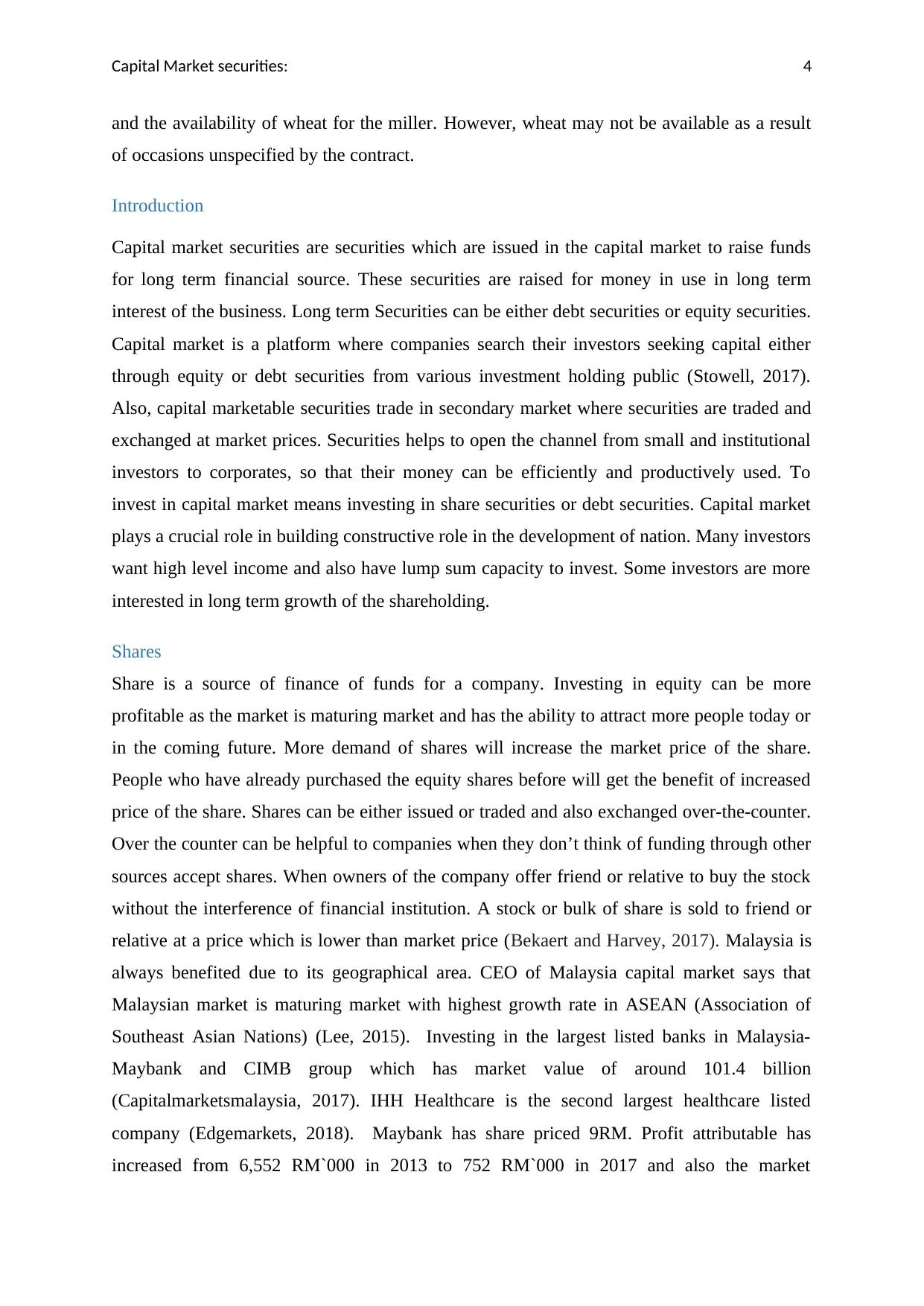
Capital Market securities: 4
and the availability of wheat for the miller. However, wheat may not be available as a result
of occasions unspecified by the contract.
Introduction
Capital market securities are securities which are issued in the capital market to raise funds
for long term financial source. These securities are raised for money in use in long term
interest of the business. Long term Securities can be either debt securities or equity securities.
Capital market is a platform where companies search their investors seeking capital either
through equity or debt securities from various investment holding public (Stowell, 2017).
Also, capital marketable securities trade in secondary market where securities are traded and
exchanged at market prices. Securities helps to open the channel from small and institutional
investors to corporates, so that their money can be efficiently and productively used. To
invest in capital market means investing in share securities or debt securities. Capital market
plays a crucial role in building constructive role in the development of nation. Many investors
want high level income and also have lump sum capacity to invest. Some investors are more
interested in long term growth of the shareholding.
Shares
Share is a source of finance of funds for a company. Investing in equity can be more
profitable as the market is maturing market and has the ability to attract more people today or
in the coming future. More demand of shares will increase the market price of the share.
People who have already purchased the equity shares before will get the benefit of increased
price of the share. Shares can be either issued or traded and also exchanged over-the-counter.
Over the counter can be helpful to companies when they don’t think of funding through other
sources accept shares. When owners of the company offer friend or relative to buy the stock
without the interference of financial institution. A stock or bulk of share is sold to friend or
relative at a price which is lower than market price (Bekaert and Harvey, 2017). Malaysia is
always benefited due to its geographical area. CEO of Malaysia capital market says that
Malaysian market is maturing market with highest growth rate in ASEAN (Association of
Southeast Asian Nations) (Lee, 2015). Investing in the largest listed banks in Malaysia-
Maybank and CIMB group which has market value of around 101.4 billion
(Capitalmarketsmalaysia, 2017). IHH Healthcare is the second largest healthcare listed
company (Edgemarkets, 2018). Maybank has share priced 9RM. Profit attributable has
increased from 6,552 RM`000 in 2013 to 752 RM`000 in 2017 and also the market
and the availability of wheat for the miller. However, wheat may not be available as a result
of occasions unspecified by the contract.
Introduction
Capital market securities are securities which are issued in the capital market to raise funds
for long term financial source. These securities are raised for money in use in long term
interest of the business. Long term Securities can be either debt securities or equity securities.
Capital market is a platform where companies search their investors seeking capital either
through equity or debt securities from various investment holding public (Stowell, 2017).
Also, capital marketable securities trade in secondary market where securities are traded and
exchanged at market prices. Securities helps to open the channel from small and institutional
investors to corporates, so that their money can be efficiently and productively used. To
invest in capital market means investing in share securities or debt securities. Capital market
plays a crucial role in building constructive role in the development of nation. Many investors
want high level income and also have lump sum capacity to invest. Some investors are more
interested in long term growth of the shareholding.
Shares
Share is a source of finance of funds for a company. Investing in equity can be more
profitable as the market is maturing market and has the ability to attract more people today or
in the coming future. More demand of shares will increase the market price of the share.
People who have already purchased the equity shares before will get the benefit of increased
price of the share. Shares can be either issued or traded and also exchanged over-the-counter.
Over the counter can be helpful to companies when they don’t think of funding through other
sources accept shares. When owners of the company offer friend or relative to buy the stock
without the interference of financial institution. A stock or bulk of share is sold to friend or
relative at a price which is lower than market price (Bekaert and Harvey, 2017). Malaysia is
always benefited due to its geographical area. CEO of Malaysia capital market says that
Malaysian market is maturing market with highest growth rate in ASEAN (Association of
Southeast Asian Nations) (Lee, 2015). Investing in the largest listed banks in Malaysia-
Maybank and CIMB group which has market value of around 101.4 billion
(Capitalmarketsmalaysia, 2017). IHH Healthcare is the second largest healthcare listed
company (Edgemarkets, 2018). Maybank has share priced 9RM. Profit attributable has
increased from 6,552 RM`000 in 2013 to 752 RM`000 in 2017 and also the market
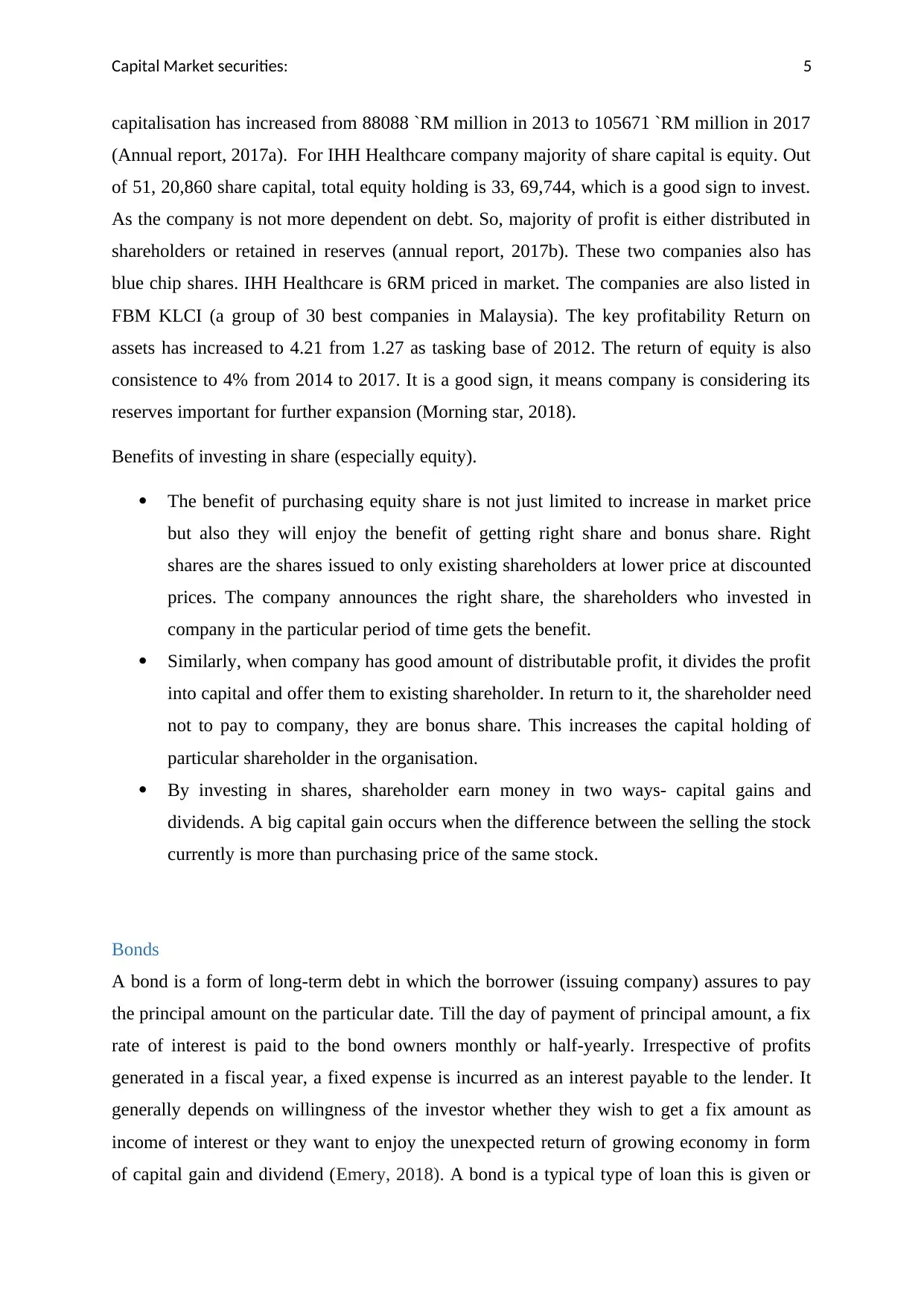
Capital Market securities: 5
capitalisation has increased from 88088 `RM million in 2013 to 105671 `RM million in 2017
(Annual report, 2017a). For IHH Healthcare company majority of share capital is equity. Out
of 51, 20,860 share capital, total equity holding is 33, 69,744, which is a good sign to invest.
As the company is not more dependent on debt. So, majority of profit is either distributed in
shareholders or retained in reserves (annual report, 2017b). These two companies also has
blue chip shares. IHH Healthcare is 6RM priced in market. The companies are also listed in
FBM KLCI (a group of 30 best companies in Malaysia). The key profitability Return on
assets has increased to 4.21 from 1.27 as tasking base of 2012. The return of equity is also
consistence to 4% from 2014 to 2017. It is a good sign, it means company is considering its
reserves important for further expansion (Morning star, 2018).
Benefits of investing in share (especially equity).
The benefit of purchasing equity share is not just limited to increase in market price
but also they will enjoy the benefit of getting right share and bonus share. Right
shares are the shares issued to only existing shareholders at lower price at discounted
prices. The company announces the right share, the shareholders who invested in
company in the particular period of time gets the benefit.
Similarly, when company has good amount of distributable profit, it divides the profit
into capital and offer them to existing shareholder. In return to it, the shareholder need
not to pay to company, they are bonus share. This increases the capital holding of
particular shareholder in the organisation.
By investing in shares, shareholder earn money in two ways- capital gains and
dividends. A big capital gain occurs when the difference between the selling the stock
currently is more than purchasing price of the same stock.
Bonds
A bond is a form of long-term debt in which the borrower (issuing company) assures to pay
the principal amount on the particular date. Till the day of payment of principal amount, a fix
rate of interest is paid to the bond owners monthly or half-yearly. Irrespective of profits
generated in a fiscal year, a fixed expense is incurred as an interest payable to the lender. It
generally depends on willingness of the investor whether they wish to get a fix amount as
income of interest or they want to enjoy the unexpected return of growing economy in form
of capital gain and dividend (Emery, 2018). A bond is a typical type of loan this is given or
capitalisation has increased from 88088 `RM million in 2013 to 105671 `RM million in 2017
(Annual report, 2017a). For IHH Healthcare company majority of share capital is equity. Out
of 51, 20,860 share capital, total equity holding is 33, 69,744, which is a good sign to invest.
As the company is not more dependent on debt. So, majority of profit is either distributed in
shareholders or retained in reserves (annual report, 2017b). These two companies also has
blue chip shares. IHH Healthcare is 6RM priced in market. The companies are also listed in
FBM KLCI (a group of 30 best companies in Malaysia). The key profitability Return on
assets has increased to 4.21 from 1.27 as tasking base of 2012. The return of equity is also
consistence to 4% from 2014 to 2017. It is a good sign, it means company is considering its
reserves important for further expansion (Morning star, 2018).
Benefits of investing in share (especially equity).
The benefit of purchasing equity share is not just limited to increase in market price
but also they will enjoy the benefit of getting right share and bonus share. Right
shares are the shares issued to only existing shareholders at lower price at discounted
prices. The company announces the right share, the shareholders who invested in
company in the particular period of time gets the benefit.
Similarly, when company has good amount of distributable profit, it divides the profit
into capital and offer them to existing shareholder. In return to it, the shareholder need
not to pay to company, they are bonus share. This increases the capital holding of
particular shareholder in the organisation.
By investing in shares, shareholder earn money in two ways- capital gains and
dividends. A big capital gain occurs when the difference between the selling the stock
currently is more than purchasing price of the same stock.
Bonds
A bond is a form of long-term debt in which the borrower (issuing company) assures to pay
the principal amount on the particular date. Till the day of payment of principal amount, a fix
rate of interest is paid to the bond owners monthly or half-yearly. Irrespective of profits
generated in a fiscal year, a fixed expense is incurred as an interest payable to the lender. It
generally depends on willingness of the investor whether they wish to get a fix amount as
income of interest or they want to enjoy the unexpected return of growing economy in form
of capital gain and dividend (Emery, 2018). A bond is a typical type of loan this is given or
⊘ This is a preview!⊘
Do you want full access?
Subscribe today to unlock all pages.

Trusted by 1+ million students worldwide
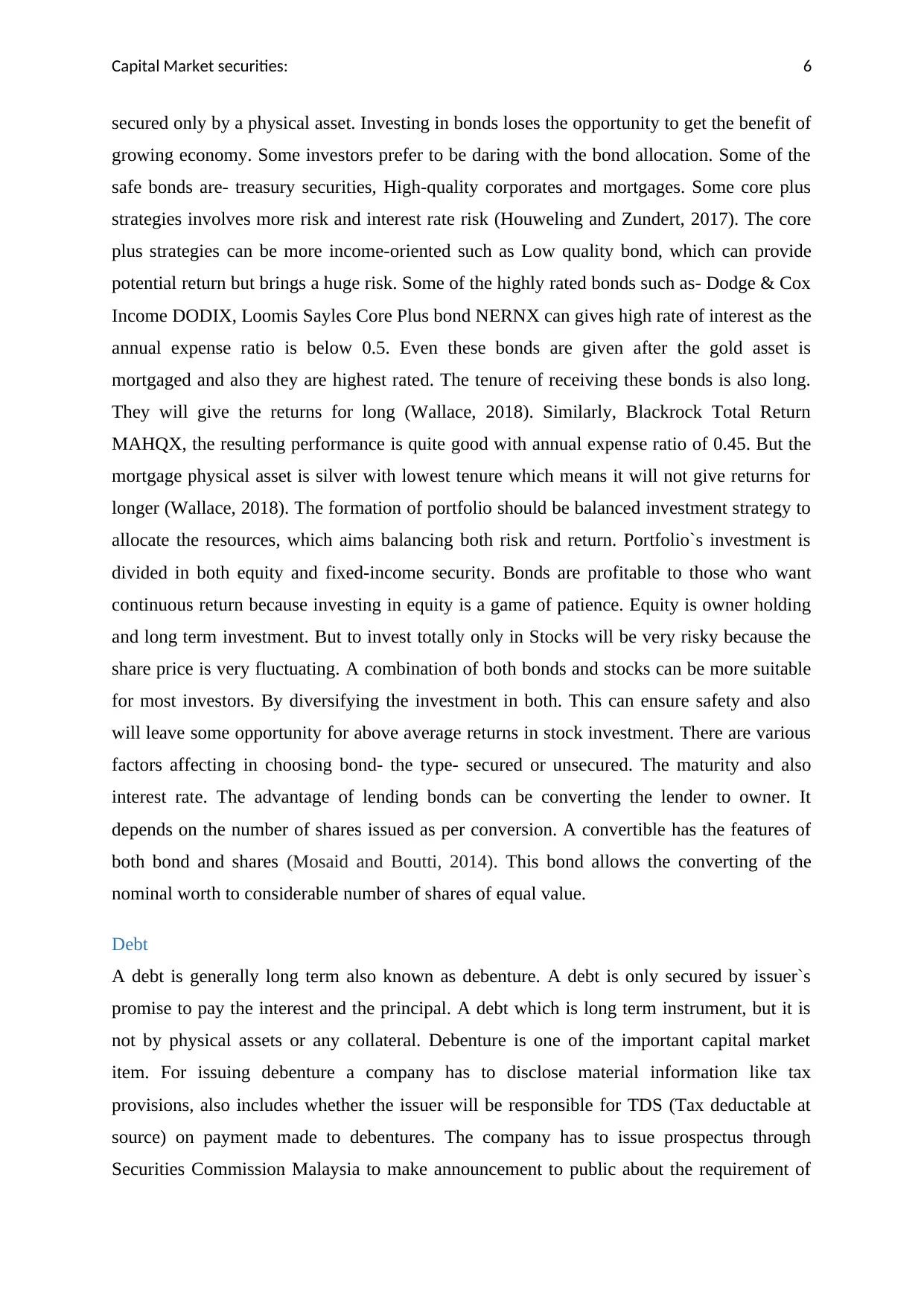
Capital Market securities: 6
secured only by a physical asset. Investing in bonds loses the opportunity to get the benefit of
growing economy. Some investors prefer to be daring with the bond allocation. Some of the
safe bonds are- treasury securities, High-quality corporates and mortgages. Some core plus
strategies involves more risk and interest rate risk (Houweling and Zundert, 2017). The core
plus strategies can be more income-oriented such as Low quality bond, which can provide
potential return but brings a huge risk. Some of the highly rated bonds such as- Dodge & Cox
Income DODIX, Loomis Sayles Core Plus bond NERNX can gives high rate of interest as the
annual expense ratio is below 0.5. Even these bonds are given after the gold asset is
mortgaged and also they are highest rated. The tenure of receiving these bonds is also long.
They will give the returns for long (Wallace, 2018). Similarly, Blackrock Total Return
MAHQX, the resulting performance is quite good with annual expense ratio of 0.45. But the
mortgage physical asset is silver with lowest tenure which means it will not give returns for
longer (Wallace, 2018). The formation of portfolio should be balanced investment strategy to
allocate the resources, which aims balancing both risk and return. Portfolio`s investment is
divided in both equity and fixed-income security. Bonds are profitable to those who want
continuous return because investing in equity is a game of patience. Equity is owner holding
and long term investment. But to invest totally only in Stocks will be very risky because the
share price is very fluctuating. A combination of both bonds and stocks can be more suitable
for most investors. By diversifying the investment in both. This can ensure safety and also
will leave some opportunity for above average returns in stock investment. There are various
factors affecting in choosing bond- the type- secured or unsecured. The maturity and also
interest rate. The advantage of lending bonds can be converting the lender to owner. It
depends on the number of shares issued as per conversion. A convertible has the features of
both bond and shares (Mosaid and Boutti, 2014). This bond allows the converting of the
nominal worth to considerable number of shares of equal value.
Debt
A debt is generally long term also known as debenture. A debt is only secured by issuer`s
promise to pay the interest and the principal. A debt which is long term instrument, but it is
not by physical assets or any collateral. Debenture is one of the important capital market
item. For issuing debenture a company has to disclose material information like tax
provisions, also includes whether the issuer will be responsible for TDS (Tax deductable at
source) on payment made to debentures. The company has to issue prospectus through
Securities Commission Malaysia to make announcement to public about the requirement of
secured only by a physical asset. Investing in bonds loses the opportunity to get the benefit of
growing economy. Some investors prefer to be daring with the bond allocation. Some of the
safe bonds are- treasury securities, High-quality corporates and mortgages. Some core plus
strategies involves more risk and interest rate risk (Houweling and Zundert, 2017). The core
plus strategies can be more income-oriented such as Low quality bond, which can provide
potential return but brings a huge risk. Some of the highly rated bonds such as- Dodge & Cox
Income DODIX, Loomis Sayles Core Plus bond NERNX can gives high rate of interest as the
annual expense ratio is below 0.5. Even these bonds are given after the gold asset is
mortgaged and also they are highest rated. The tenure of receiving these bonds is also long.
They will give the returns for long (Wallace, 2018). Similarly, Blackrock Total Return
MAHQX, the resulting performance is quite good with annual expense ratio of 0.45. But the
mortgage physical asset is silver with lowest tenure which means it will not give returns for
longer (Wallace, 2018). The formation of portfolio should be balanced investment strategy to
allocate the resources, which aims balancing both risk and return. Portfolio`s investment is
divided in both equity and fixed-income security. Bonds are profitable to those who want
continuous return because investing in equity is a game of patience. Equity is owner holding
and long term investment. But to invest totally only in Stocks will be very risky because the
share price is very fluctuating. A combination of both bonds and stocks can be more suitable
for most investors. By diversifying the investment in both. This can ensure safety and also
will leave some opportunity for above average returns in stock investment. There are various
factors affecting in choosing bond- the type- secured or unsecured. The maturity and also
interest rate. The advantage of lending bonds can be converting the lender to owner. It
depends on the number of shares issued as per conversion. A convertible has the features of
both bond and shares (Mosaid and Boutti, 2014). This bond allows the converting of the
nominal worth to considerable number of shares of equal value.
Debt
A debt is generally long term also known as debenture. A debt is only secured by issuer`s
promise to pay the interest and the principal. A debt which is long term instrument, but it is
not by physical assets or any collateral. Debenture is one of the important capital market
item. For issuing debenture a company has to disclose material information like tax
provisions, also includes whether the issuer will be responsible for TDS (Tax deductable at
source) on payment made to debentures. The company has to issue prospectus through
Securities Commission Malaysia to make announcement to public about the requirement of
Paraphrase This Document
Need a fresh take? Get an instant paraphrase of this document with our AI Paraphraser
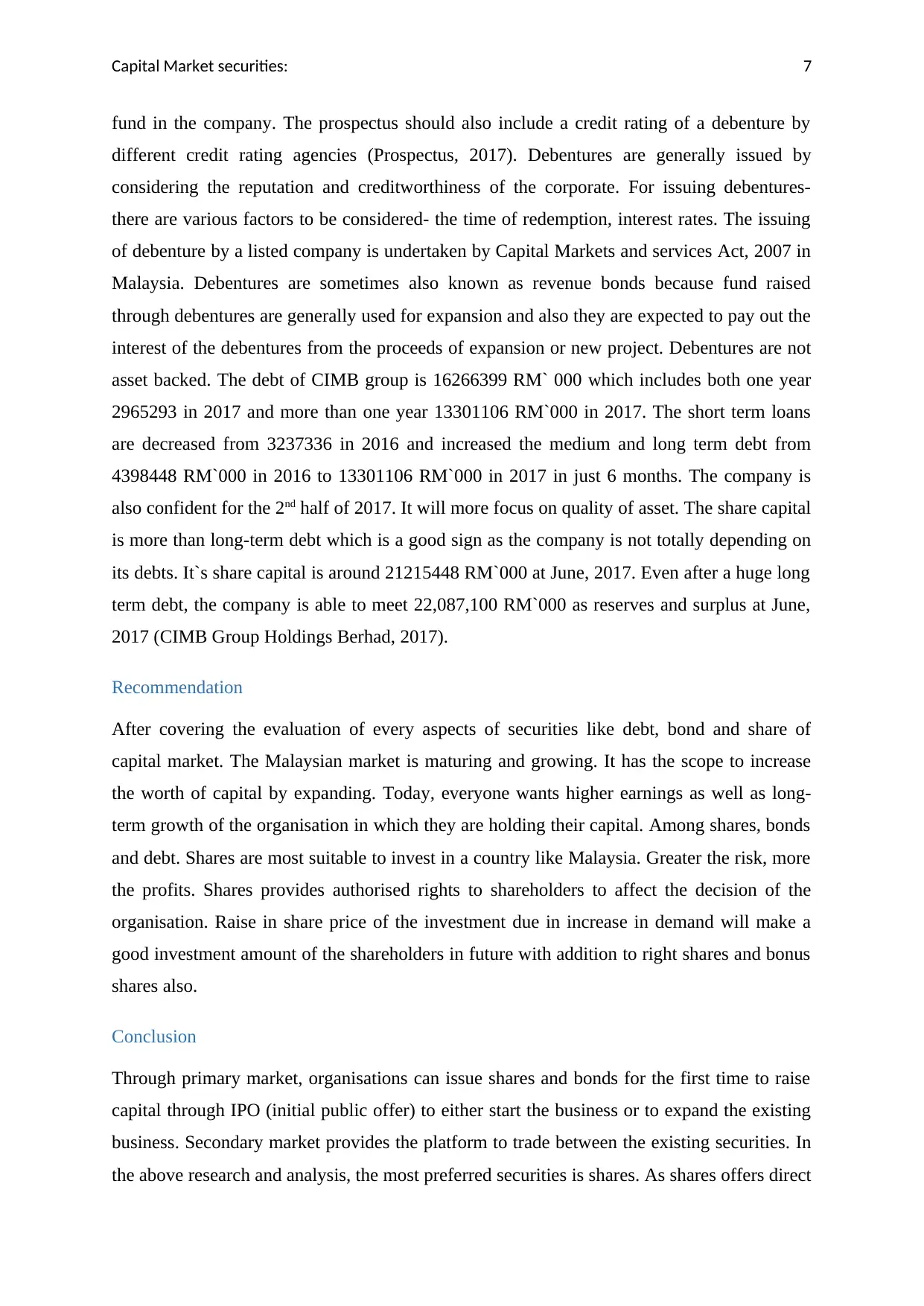
Capital Market securities: 7
fund in the company. The prospectus should also include a credit rating of a debenture by
different credit rating agencies (Prospectus, 2017). Debentures are generally issued by
considering the reputation and creditworthiness of the corporate. For issuing debentures-
there are various factors to be considered- the time of redemption, interest rates. The issuing
of debenture by a listed company is undertaken by Capital Markets and services Act, 2007 in
Malaysia. Debentures are sometimes also known as revenue bonds because fund raised
through debentures are generally used for expansion and also they are expected to pay out the
interest of the debentures from the proceeds of expansion or new project. Debentures are not
asset backed. The debt of CIMB group is 16266399 RM` 000 which includes both one year
2965293 in 2017 and more than one year 13301106 RM`000 in 2017. The short term loans
are decreased from 3237336 in 2016 and increased the medium and long term debt from
4398448 RM`000 in 2016 to 13301106 RM`000 in 2017 in just 6 months. The company is
also confident for the 2nd half of 2017. It will more focus on quality of asset. The share capital
is more than long-term debt which is a good sign as the company is not totally depending on
its debts. It`s share capital is around 21215448 RM`000 at June, 2017. Even after a huge long
term debt, the company is able to meet 22,087,100 RM`000 as reserves and surplus at June,
2017 (CIMB Group Holdings Berhad, 2017).
Recommendation
After covering the evaluation of every aspects of securities like debt, bond and share of
capital market. The Malaysian market is maturing and growing. It has the scope to increase
the worth of capital by expanding. Today, everyone wants higher earnings as well as long-
term growth of the organisation in which they are holding their capital. Among shares, bonds
and debt. Shares are most suitable to invest in a country like Malaysia. Greater the risk, more
the profits. Shares provides authorised rights to shareholders to affect the decision of the
organisation. Raise in share price of the investment due in increase in demand will make a
good investment amount of the shareholders in future with addition to right shares and bonus
shares also.
Conclusion
Through primary market, organisations can issue shares and bonds for the first time to raise
capital through IPO (initial public offer) to either start the business or to expand the existing
business. Secondary market provides the platform to trade between the existing securities. In
the above research and analysis, the most preferred securities is shares. As shares offers direct
fund in the company. The prospectus should also include a credit rating of a debenture by
different credit rating agencies (Prospectus, 2017). Debentures are generally issued by
considering the reputation and creditworthiness of the corporate. For issuing debentures-
there are various factors to be considered- the time of redemption, interest rates. The issuing
of debenture by a listed company is undertaken by Capital Markets and services Act, 2007 in
Malaysia. Debentures are sometimes also known as revenue bonds because fund raised
through debentures are generally used for expansion and also they are expected to pay out the
interest of the debentures from the proceeds of expansion or new project. Debentures are not
asset backed. The debt of CIMB group is 16266399 RM` 000 which includes both one year
2965293 in 2017 and more than one year 13301106 RM`000 in 2017. The short term loans
are decreased from 3237336 in 2016 and increased the medium and long term debt from
4398448 RM`000 in 2016 to 13301106 RM`000 in 2017 in just 6 months. The company is
also confident for the 2nd half of 2017. It will more focus on quality of asset. The share capital
is more than long-term debt which is a good sign as the company is not totally depending on
its debts. It`s share capital is around 21215448 RM`000 at June, 2017. Even after a huge long
term debt, the company is able to meet 22,087,100 RM`000 as reserves and surplus at June,
2017 (CIMB Group Holdings Berhad, 2017).
Recommendation
After covering the evaluation of every aspects of securities like debt, bond and share of
capital market. The Malaysian market is maturing and growing. It has the scope to increase
the worth of capital by expanding. Today, everyone wants higher earnings as well as long-
term growth of the organisation in which they are holding their capital. Among shares, bonds
and debt. Shares are most suitable to invest in a country like Malaysia. Greater the risk, more
the profits. Shares provides authorised rights to shareholders to affect the decision of the
organisation. Raise in share price of the investment due in increase in demand will make a
good investment amount of the shareholders in future with addition to right shares and bonus
shares also.
Conclusion
Through primary market, organisations can issue shares and bonds for the first time to raise
capital through IPO (initial public offer) to either start the business or to expand the existing
business. Secondary market provides the platform to trade between the existing securities. In
the above research and analysis, the most preferred securities is shares. As shares offers direct
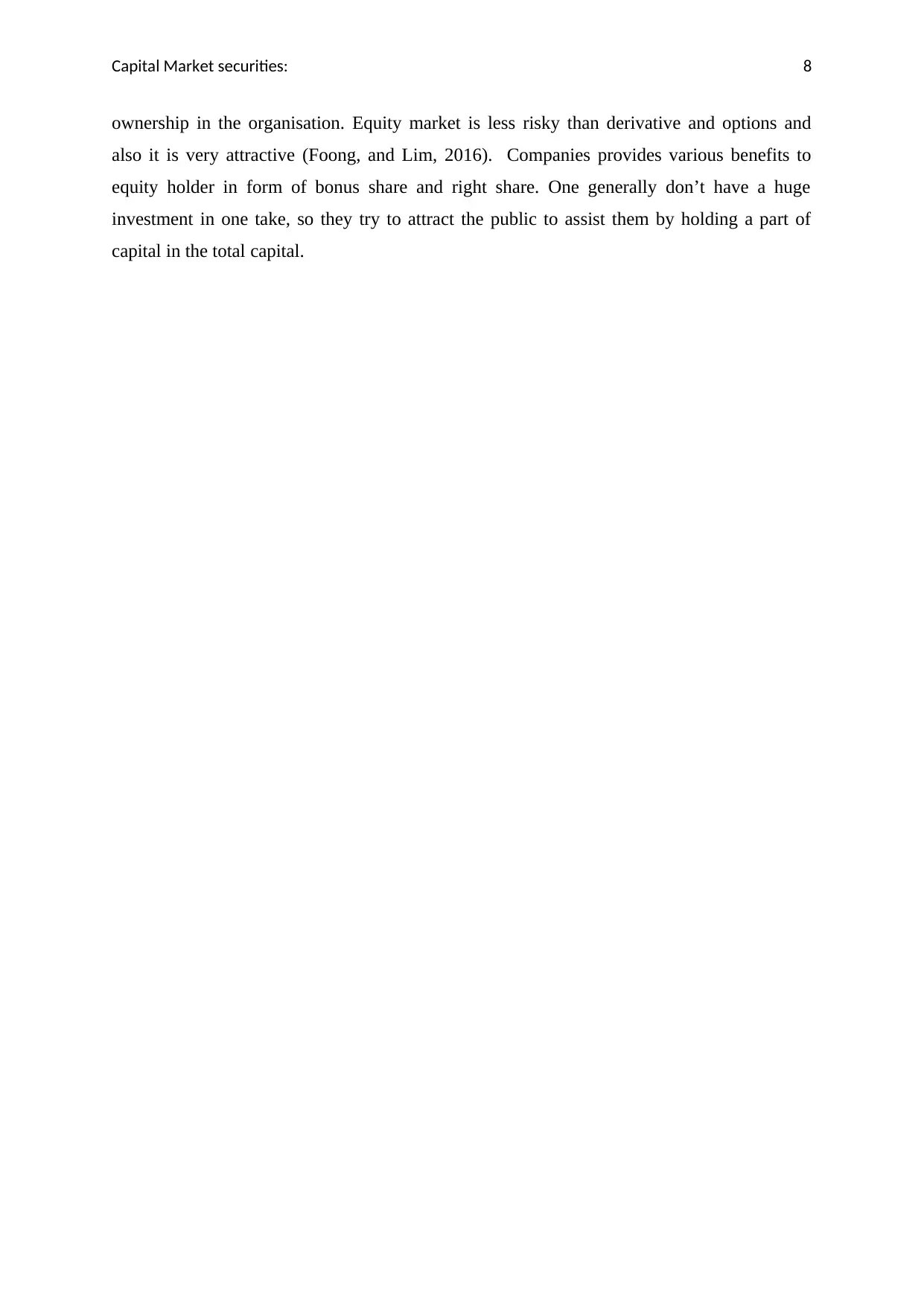
Capital Market securities: 8
ownership in the organisation. Equity market is less risky than derivative and options and
also it is very attractive (Foong, and Lim, 2016). Companies provides various benefits to
equity holder in form of bonus share and right share. One generally don’t have a huge
investment in one take, so they try to attract the public to assist them by holding a part of
capital in the total capital.
ownership in the organisation. Equity market is less risky than derivative and options and
also it is very attractive (Foong, and Lim, 2016). Companies provides various benefits to
equity holder in form of bonus share and right share. One generally don’t have a huge
investment in one take, so they try to attract the public to assist them by holding a part of
capital in the total capital.
⊘ This is a preview!⊘
Do you want full access?
Subscribe today to unlock all pages.

Trusted by 1+ million students worldwide

Capital Market securities: 9
Paraphrase This Document
Need a fresh take? Get an instant paraphrase of this document with our AI Paraphraser
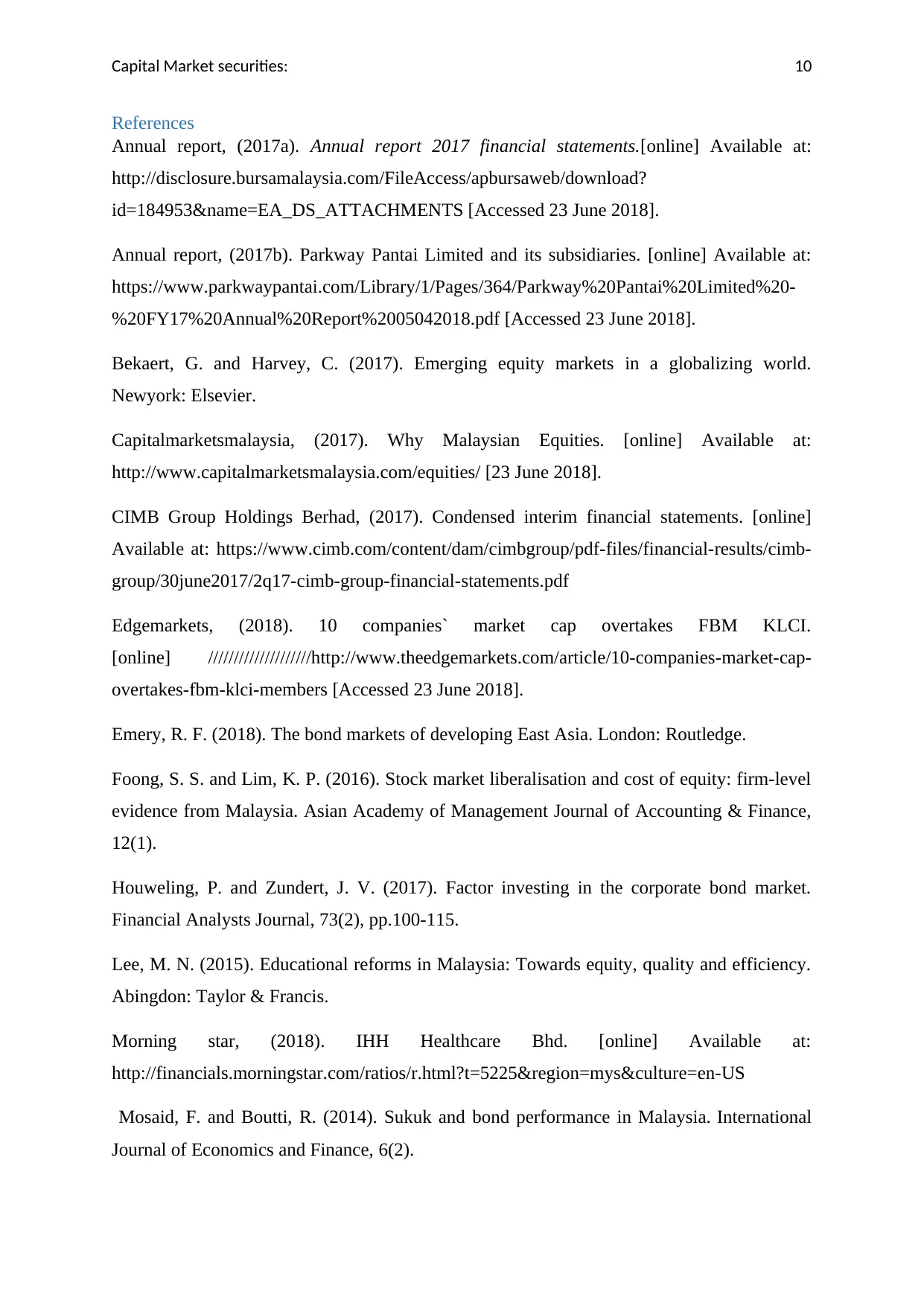
Capital Market securities: 10
References
Annual report, (2017a). Annual report 2017 financial statements.[online] Available at:
http://disclosure.bursamalaysia.com/FileAccess/apbursaweb/download?
id=184953&name=EA_DS_ATTACHMENTS [Accessed 23 June 2018].
Annual report, (2017b). Parkway Pantai Limited and its subsidiaries. [online] Available at:
https://www.parkwaypantai.com/Library/1/Pages/364/Parkway%20Pantai%20Limited%20-
%20FY17%20Annual%20Report%2005042018.pdf [Accessed 23 June 2018].
Bekaert, G. and Harvey, C. (2017). Emerging equity markets in a globalizing world.
Newyork: Elsevier.
Capitalmarketsmalaysia, (2017). Why Malaysian Equities. [online] Available at:
http://www.capitalmarketsmalaysia.com/equities/ [23 June 2018].
CIMB Group Holdings Berhad, (2017). Condensed interim financial statements. [online]
Available at: https://www.cimb.com/content/dam/cimbgroup/pdf-files/financial-results/cimb-
group/30june2017/2q17-cimb-group-financial-statements.pdf
Edgemarkets, (2018). 10 companies` market cap overtakes FBM KLCI.
[online] ////////////////////http://www.theedgemarkets.com/article/10-companies-market-cap-
overtakes-fbm-klci-members [Accessed 23 June 2018].
Emery, R. F. (2018). The bond markets of developing East Asia. London: Routledge.
Foong, S. S. and Lim, K. P. (2016). Stock market liberalisation and cost of equity: firm-level
evidence from Malaysia. Asian Academy of Management Journal of Accounting & Finance,
12(1).
Houweling, P. and Zundert, J. V. (2017). Factor investing in the corporate bond market.
Financial Analysts Journal, 73(2), pp.100-115.
Lee, M. N. (2015). Educational reforms in Malaysia: Towards equity, quality and efficiency.
Abingdon: Taylor & Francis.
Morning star, (2018). IHH Healthcare Bhd. [online] Available at:
http://financials.morningstar.com/ratios/r.html?t=5225®ion=mys&culture=en-US
Mosaid, F. and Boutti, R. (2014). Sukuk and bond performance in Malaysia. International
Journal of Economics and Finance, 6(2).
References
Annual report, (2017a). Annual report 2017 financial statements.[online] Available at:
http://disclosure.bursamalaysia.com/FileAccess/apbursaweb/download?
id=184953&name=EA_DS_ATTACHMENTS [Accessed 23 June 2018].
Annual report, (2017b). Parkway Pantai Limited and its subsidiaries. [online] Available at:
https://www.parkwaypantai.com/Library/1/Pages/364/Parkway%20Pantai%20Limited%20-
%20FY17%20Annual%20Report%2005042018.pdf [Accessed 23 June 2018].
Bekaert, G. and Harvey, C. (2017). Emerging equity markets in a globalizing world.
Newyork: Elsevier.
Capitalmarketsmalaysia, (2017). Why Malaysian Equities. [online] Available at:
http://www.capitalmarketsmalaysia.com/equities/ [23 June 2018].
CIMB Group Holdings Berhad, (2017). Condensed interim financial statements. [online]
Available at: https://www.cimb.com/content/dam/cimbgroup/pdf-files/financial-results/cimb-
group/30june2017/2q17-cimb-group-financial-statements.pdf
Edgemarkets, (2018). 10 companies` market cap overtakes FBM KLCI.
[online] ////////////////////http://www.theedgemarkets.com/article/10-companies-market-cap-
overtakes-fbm-klci-members [Accessed 23 June 2018].
Emery, R. F. (2018). The bond markets of developing East Asia. London: Routledge.
Foong, S. S. and Lim, K. P. (2016). Stock market liberalisation and cost of equity: firm-level
evidence from Malaysia. Asian Academy of Management Journal of Accounting & Finance,
12(1).
Houweling, P. and Zundert, J. V. (2017). Factor investing in the corporate bond market.
Financial Analysts Journal, 73(2), pp.100-115.
Lee, M. N. (2015). Educational reforms in Malaysia: Towards equity, quality and efficiency.
Abingdon: Taylor & Francis.
Morning star, (2018). IHH Healthcare Bhd. [online] Available at:
http://financials.morningstar.com/ratios/r.html?t=5225®ion=mys&culture=en-US
Mosaid, F. and Boutti, R. (2014). Sukuk and bond performance in Malaysia. International
Journal of Economics and Finance, 6(2).
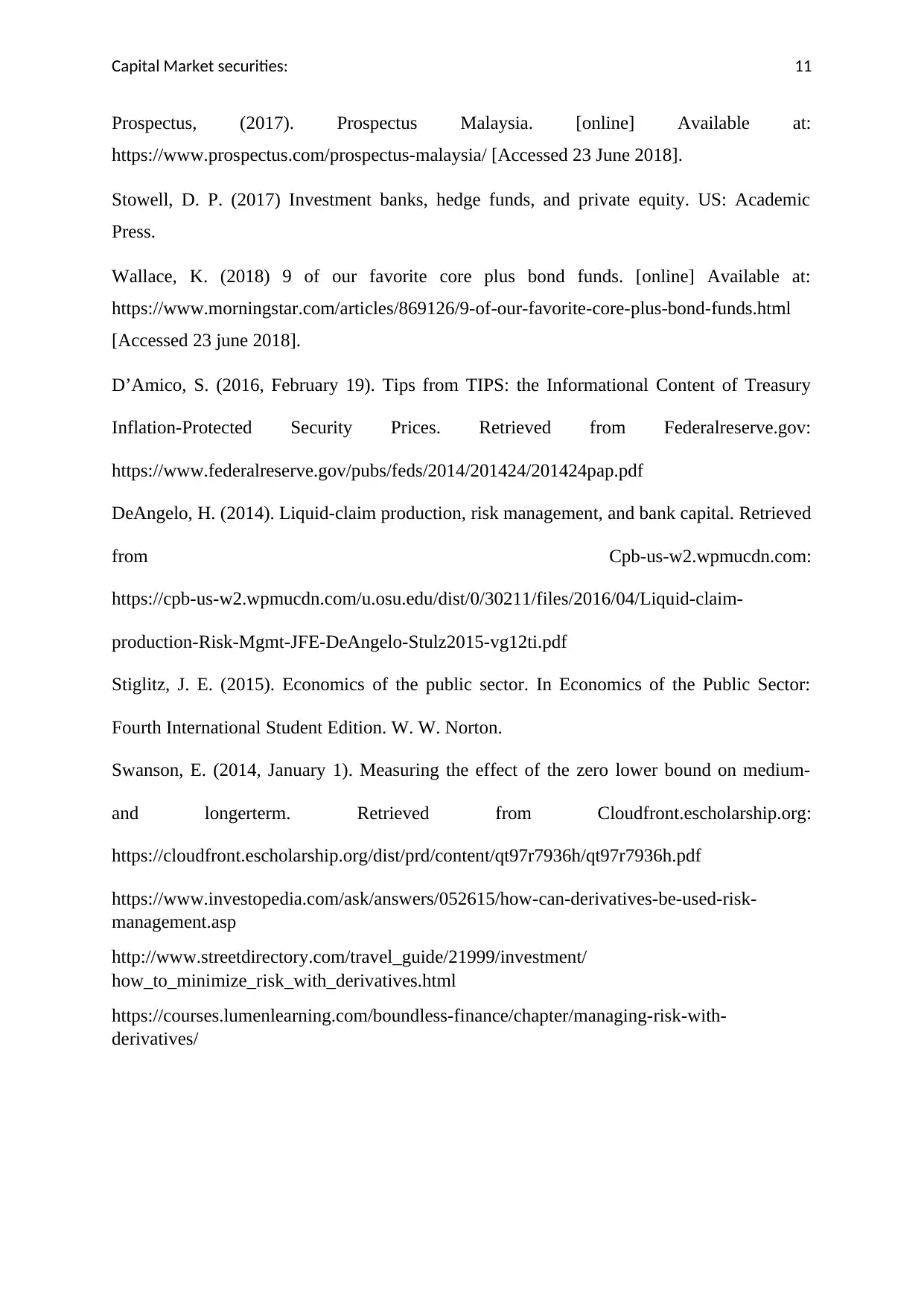
Capital Market securities: 11
Prospectus, (2017). Prospectus Malaysia. [online] Available at:
https://www.prospectus.com/prospectus-malaysia/ [Accessed 23 June 2018].
Stowell, D. P. (2017) Investment banks, hedge funds, and private equity. US: Academic
Press.
Wallace, K. (2018) 9 of our favorite core plus bond funds. [online] Available at:
https://www.morningstar.com/articles/869126/9-of-our-favorite-core-plus-bond-funds.html
[Accessed 23 june 2018].
D’Amico, S. (2016, February 19). Tips from TIPS: the Informational Content of Treasury
Inflation-Protected Security Prices. Retrieved from Federalreserve.gov:
https://www.federalreserve.gov/pubs/feds/2014/201424/201424pap.pdf
DeAngelo, H. (2014). Liquid-claim production, risk management, and bank capital. Retrieved
from Cpb-us-w2.wpmucdn.com:
https://cpb-us-w2.wpmucdn.com/u.osu.edu/dist/0/30211/files/2016/04/Liquid-claim-
production-Risk-Mgmt-JFE-DeAngelo-Stulz2015-vg12ti.pdf
Stiglitz, J. E. (2015). Economics of the public sector. In Economics of the Public Sector:
Fourth International Student Edition. W. W. Norton.
Swanson, E. (2014, January 1). Measuring the effect of the zero lower bound on medium-
and longerterm. Retrieved from Cloudfront.escholarship.org:
https://cloudfront.escholarship.org/dist/prd/content/qt97r7936h/qt97r7936h.pdf
https://www.investopedia.com/ask/answers/052615/how-can-derivatives-be-used-risk-
management.asp
http://www.streetdirectory.com/travel_guide/21999/investment/
how_to_minimize_risk_with_derivatives.html
https://courses.lumenlearning.com/boundless-finance/chapter/managing-risk-with-
derivatives/
Prospectus, (2017). Prospectus Malaysia. [online] Available at:
https://www.prospectus.com/prospectus-malaysia/ [Accessed 23 June 2018].
Stowell, D. P. (2017) Investment banks, hedge funds, and private equity. US: Academic
Press.
Wallace, K. (2018) 9 of our favorite core plus bond funds. [online] Available at:
https://www.morningstar.com/articles/869126/9-of-our-favorite-core-plus-bond-funds.html
[Accessed 23 june 2018].
D’Amico, S. (2016, February 19). Tips from TIPS: the Informational Content of Treasury
Inflation-Protected Security Prices. Retrieved from Federalreserve.gov:
https://www.federalreserve.gov/pubs/feds/2014/201424/201424pap.pdf
DeAngelo, H. (2014). Liquid-claim production, risk management, and bank capital. Retrieved
from Cpb-us-w2.wpmucdn.com:
https://cpb-us-w2.wpmucdn.com/u.osu.edu/dist/0/30211/files/2016/04/Liquid-claim-
production-Risk-Mgmt-JFE-DeAngelo-Stulz2015-vg12ti.pdf
Stiglitz, J. E. (2015). Economics of the public sector. In Economics of the Public Sector:
Fourth International Student Edition. W. W. Norton.
Swanson, E. (2014, January 1). Measuring the effect of the zero lower bound on medium-
and longerterm. Retrieved from Cloudfront.escholarship.org:
https://cloudfront.escholarship.org/dist/prd/content/qt97r7936h/qt97r7936h.pdf
https://www.investopedia.com/ask/answers/052615/how-can-derivatives-be-used-risk-
management.asp
http://www.streetdirectory.com/travel_guide/21999/investment/
how_to_minimize_risk_with_derivatives.html
https://courses.lumenlearning.com/boundless-finance/chapter/managing-risk-with-
derivatives/
⊘ This is a preview!⊘
Do you want full access?
Subscribe today to unlock all pages.

Trusted by 1+ million students worldwide
1 out of 12
Related Documents
Your All-in-One AI-Powered Toolkit for Academic Success.
+13062052269
info@desklib.com
Available 24*7 on WhatsApp / Email
![[object Object]](/_next/static/media/star-bottom.7253800d.svg)
Unlock your academic potential
Copyright © 2020–2025 A2Z Services. All Rights Reserved. Developed and managed by ZUCOL.





